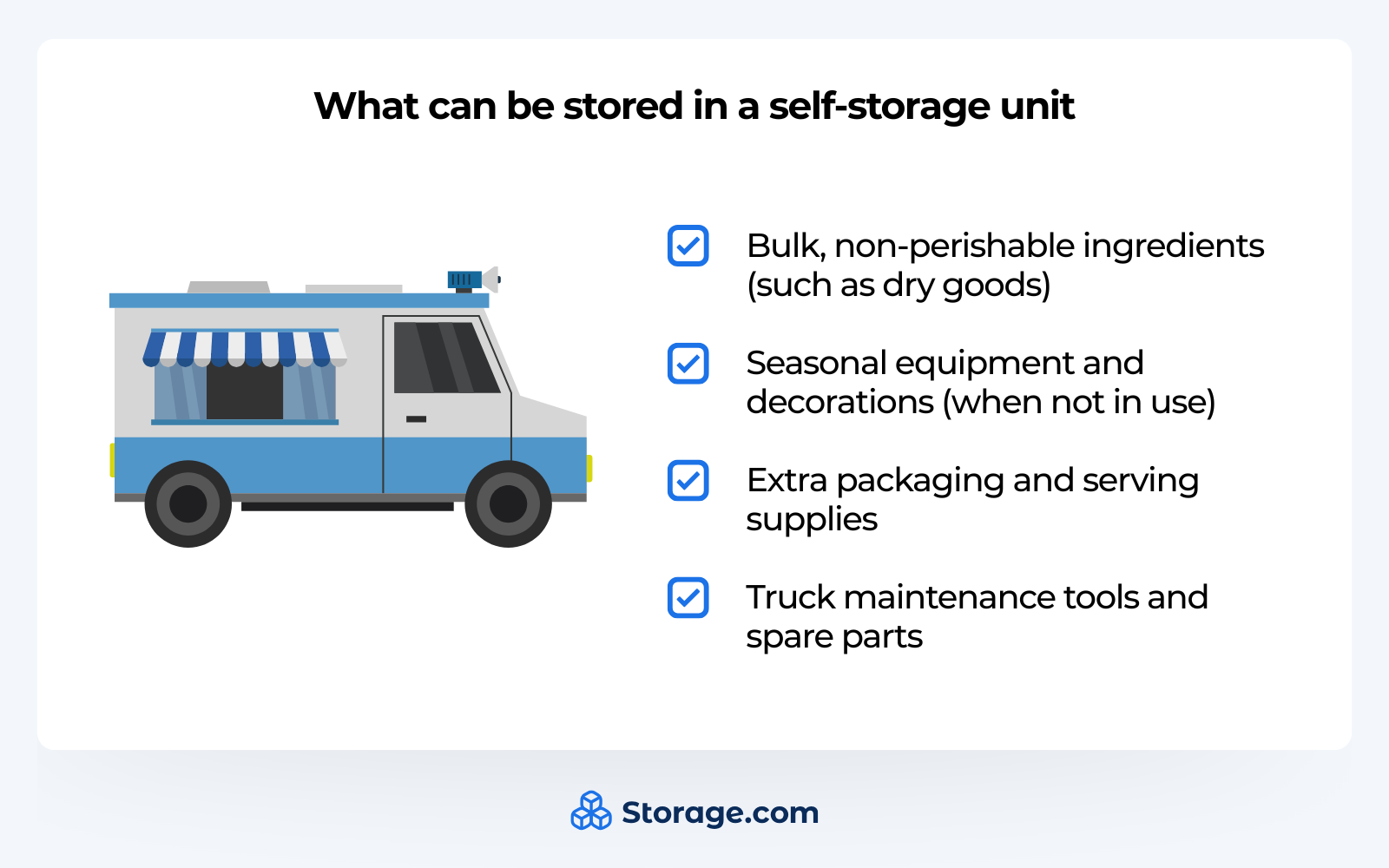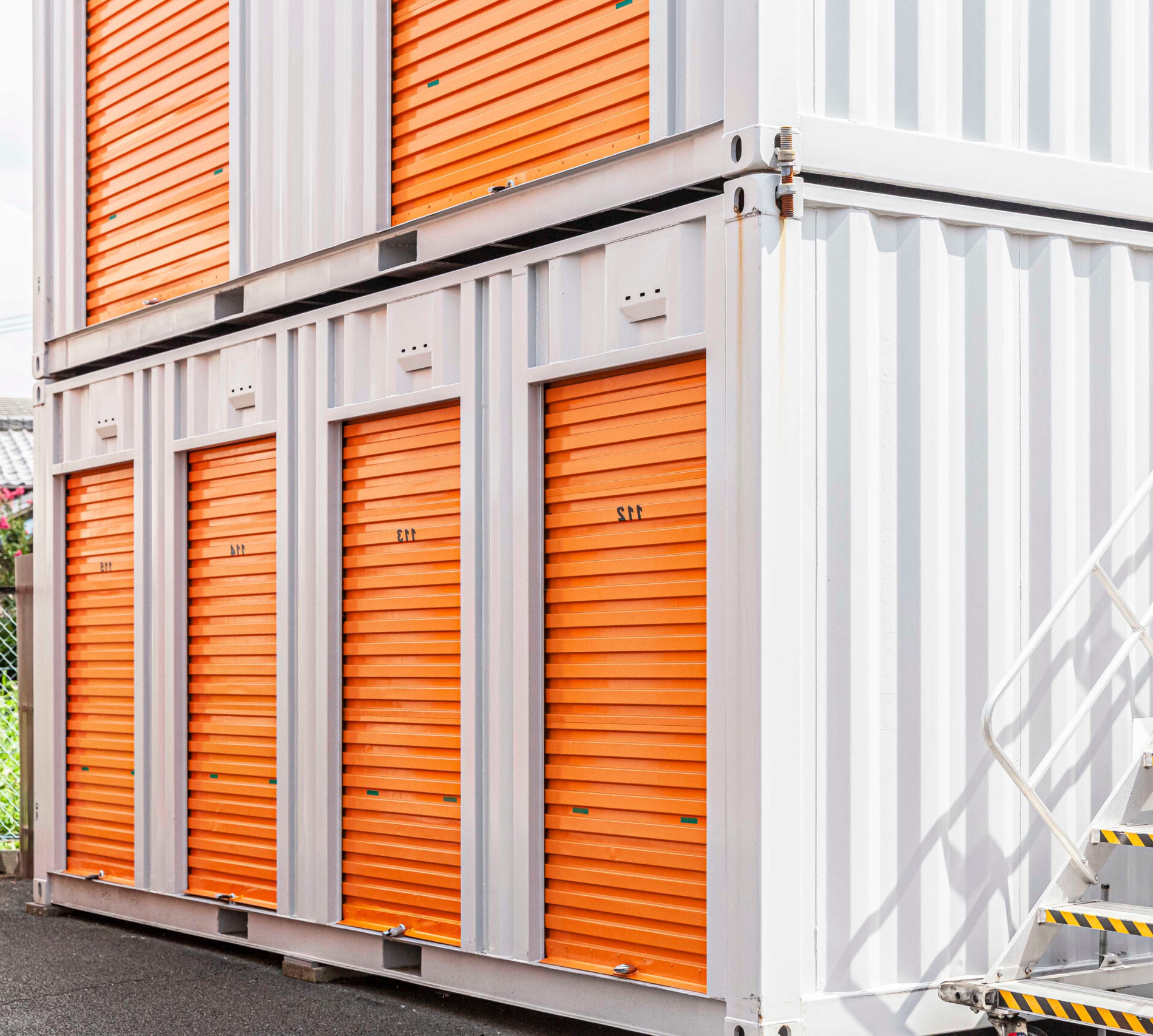Article takeaways
- Food truck kitchens have limited space, so organizing them well is key to a clean and efficient operation.
- There are many options available for storage in mobile kitchens depending on your needs, such as cabinets, overhead racks, and magnetic knife strips.
- Renting a storage unit will give you a place to store non-perishable ingredients and supplies and save space in your truck.
Food trucks are popular, mobile, and fun businesses, but owning and operating one comes with several challenges, especially limited space. A messy food truck will get in the way of your ability to cook and serve food efficiently, reducing profits and making customers unhappy. Fortunately, there are plenty of ways to organize and declutter your mobile kitchen so you can operate your food truck business without mess or hassle.
From space-saving kitchen organizers to multi-purpose tools, as well as self-storage solutions for bulk supplies that you can’t fit in your truck, this article will break down several suggestions to clear out space in your mobile kitchen and ensure your food truck operations run smoothly every time.
What space constraints do I need to consider when organizing a food truck?
Food trucks boast mobility and convenience, but you’ll have to trade this off for limited space to run your business. Ovens, stoves, and refrigerators/freezers take up plenty of space on their own, but your utensils and ingredients will also quickly eat up extra free space, and you’ll also need to consider where your point-of-sale systems, bowls and plates, and cleaning supplies will go.
When organizing your food truck, put health and safety first–keep perishable ingredients in airtight spaces protected from moisture, and keep sharp objects out of the way of employees. Your workflow will also have an impact on how your kitchen is organized, so think about how ingredients and plates will move through the space.
What options are available for storing items inside my food truck?
Let’s go over a few simple solutions for your food truck organization needs.
In-kitchen cabinets
Nonperishable dry goods, ingredients, utensils, and other supplies can easily be stored inside your truck, and there are plenty of cabinet systems available to organize your space to best fit your needs. Your mobile kitchen may already have cabinets built into it, but if not, it’s easy to purchase modular cabinets of many sizes at restaurant supply stores–just make sure you measure your kitchen space and make a plan before you go shopping.
Stainless steel should be your material of choice for your mobile kitchen cabinets, as it’s a small space and can get quite hot; this material won’t warp and can withstand sudden temperature changes. You should also consider which cabinets require extra moisture-proofing or insulation to make sure certain ingredients aren’t ruined by humidity. Many of these cabinets can be mounted against the truck wall in whatever free space you have.
Overhead storage
To make the most of your limited kitchen space in a food truck, consider vertical and overhead storage options. Many cabinet options can be mounted on the ceiling, as can racks for storing your cooking supplies and smaller dry goods that can be exposed to heat and moisture safely.
However, overhead storage comes with its concerns. You’ll need to consider weight distribution among your cabinets and racks so the mounting holds up and your truck isn’t weighted too much to one side. You should also consider how easy your cabinets are to access, as overhead storage isn’t always as convenient if arranged improperly.
Custom and specialized storage
Commercial kitchen storage comes with concerns you won’t find in a home kitchen, such as high temperatures and large messes. It’s worth investing in storage solutions that can address these concerns, such as temperature/humidity-controlled cabinets and surfaces that are easy to clean.
Stainless steel cabinets and other storage solutions can put up with these high temperatures and are simple to wipe down. Valuable dry goods, tools, and cash on hand can also be safely stored in locked cabinets to prevent thieves or intruders from getting their hands on them.
What are the best practices for organizing a food truck kitchen?

Once you’ve got some cabinets or other storage solutions in place, use a plan to organize your kitchen according to your needs. Let’s go over a few strategies for food truck organization.
Zone-based organization
Kitchens of all kinds will benefit if your supplies, utensils, and dry goods are organized based on where they come into play in the prep, cooking, and serving process. Store your prep knives and cutting boards near your prep area, your pots and pans near your stove and ovens, and your serving utensils and tools near the counter.
Use knife organizers or magnetic strips to keep your tools handy and reduce clutter in the prep area, and set your cooking station up like an assembly line so food can safely and efficiently flow in and out of ovens and stovetops. Make sure your cabinets are organized such that there’s plenty of room to walk to and from the serving counter when food is ready to deliver.
Inventory management
Any restaurant kitchen should follow a FIFO (First In, First Out) system–the first ingredients you store in the truck should be the first ones you use when cooking to keep food fresh and eliminate the risk of expiration or foodborne illnesses. Clearly label ingredients with the date and time you obtained them, and use the earliest ones first when preparing a dish.
With a little know-how, you can track day-to-day inventory using Excel or Sheets, but there are plenty of dedicated programs, services, and applications available that can make automatic inventory tracking easier, especially as you sell specific food items. Many point-of-sale (POS) software solutions, such as Square, will enable you to link specific products to the inventory that goes into making them and automatically update inventory as they’re sold.
Vertical space optimization
As mentioned above, the limited space in food trucks will be easier to deal with if you use the vertical space you have. Alongside ceiling-mounted cabinets and racks, you can mount hooks on the walls to hang pots and pans from, and magnetic knife strips attached to the wall will allow you to save drawer and countertop space when storing your knives and other important metal utensils.
Ceiling racks are best suited for storing lightweight, durable, non-dangerous objects, but you still need to consider weight distribution to avoid accidents or imbalance in your truck. Evenly distribute any ceiling-mounted racks and take care to secure any tools you keep in overhead storage so they don’t slide around.
Multi-purpose solutions
Investing in equipment and storage that serves multiple needs at once can help you save quite a bit of space in your mobile kitchen. Seek out countertops with built-in stainless steel cabinets so you can store necessary goods inside them, and look into equipment that can be used for multiple purposes, such as a “spoonula” which covers both spoon and spatula needs.
Food containers can also help you save space if you purchase nesting or collapsible containers. Nesting containers can be stored within each other, and collapsible containers can break down into smaller sizes when not in use, making them easier to store between uses.
When should I consider a self-storage unit for my food truck needs?

To further save space in your food truck kitchen, it’s worth seeking out a self-storage unit to store some of your non-perishable supplies that you don’t need every day. Perishables and wet goods can’t be stored in a unit, but items you can safely store include:
- Bulk, non-perishable ingredients (such as dry goods)
- Seasonal equipment and decorations (when not in use)
- Extra packaging and serving supplies
- Truck maintenance tools and spare parts
Storing these items in a self-storage unit will reduce your need to load new inventory daily, as you can simply bulk order some of your dry goods and store them in the unit, additionally saving you money long-term on bulk purchases. This will also help you secure your backup non-perishables in case of an accident on the truck that renders some of your ingredients unusable.
Depending on how much business you do, you’ll want to choose a storage unit that can easily fit all your supplies while leaving you room to move around, restock, and take inventory when you need to. A climate-controlled unit will further protect sensitive items from being spoiled, and a facility close to your food truck’s home base will significantly reduce your daily set-up and load-in time.
How else can I save space in my mobile kitchen?
Even with all the above solutions in place, there are plenty more ways to further optimize your food truck space–here are just a few suggestions.
Creative storage solutions
Save space and money by using items you already have on hand for storage, such as unused pitchers and vases for storing your long-handled cooking utensils. Magnetic knife strips can also serve multiple purposes, such as doubling as magnetic spice racks to store spices on with a little magnetic DIY know-how.
Any open wall space will allow you to install a stainless steel shelf, so take advantage of what you have available. Some shelves will also be easy to install on the outside of cabinet doors, allowing you to store goods that don’t need the protection of a cabinet while maximizing your space.
Choosing space-saving equipment
Like the “spoonulas” mentioned above, utensils and kitchen tools that serve multiple functions will save space in your kitchen, little by little. Only purchase the tools you need, such as a solid chef’s knife that can handle any prep tasks you throw at it, and don’t do any further shopping until you’re aware of what space you have left.
Nesting, collapsible, and stackable bowls and cutting boards will help you save cabinet space, as will the aforementioned nesting and stackable storage containers. These items will fit inside one another when not in use, freeing up more cabinet space to store more important prep items.
Making good daily organization habits
Spending a little time at the beginning and end of each workday to organize and declutter your space will save you from having to dedicate too much time to cleaning up later on. Wash, dry, and put away any dirty tools or utensils, check your dry goods to make sure none have expired, and wipe down your stainless steel surfaces to keep them free of stains.
Reorder bulk goods well in advance, and take advantage of bulk pricing–having a storage unit will minimize your risk of overstocking, giving you plenty of backup to rotate in if some of your supplies go bad. Finally, make regular visits to your unit to organize and declutter it, giving you more room to store supplies.
In conclusion
Choosing the right cabinets, maximizing your vertical space, organizing supplies by zone, and renting a storage unit to hold extra supplies will go a long way toward organizing your food truck and maximizing your ability to keep customers happy. Once you know what solutions are best for your business, take a trip to a restaurant supply store or contact a custom cabinet company to get a quote on a kitchen remodel (more expensive, but built to your specific needs).
Storage goes further than just storing supplies, however, you’ll want to look into storing your truck itself, whether it’s long-term parking or climate-controlled vehicle storage. Estimating prices and getting quotes is simple with Storage.com’s search tool–find facilities near you that have the features and unit sizes your food truck business needs. Or call us at 833-448-1067 to speak to a storage expert and get personalized advice.






